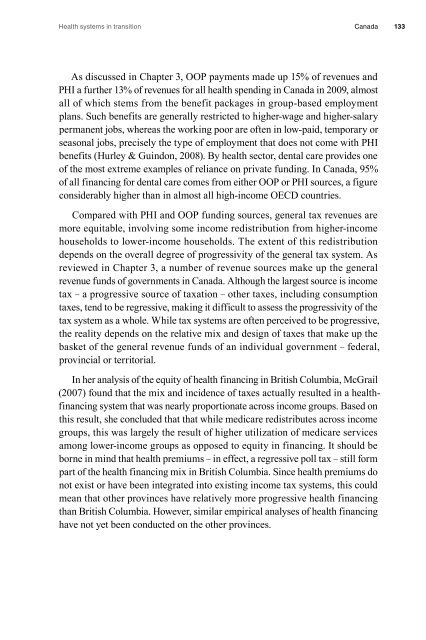Canada - World Health Organization Regional Office for Europe
Canada - World Health Organization Regional Office for Europe
Canada - World Health Organization Regional Office for Europe
Create successful ePaper yourself
Turn your PDF publications into a flip-book with our unique Google optimized e-Paper software.
<strong>Health</strong> systems in transition <strong>Canada</strong> 133<br />
As discussed in Chapter 3, OOP payments made up 15% of revenues and<br />
PHI a further 13% of revenues <strong>for</strong> all health spending in <strong>Canada</strong> in 2009, almost<br />
all of which stems from the benefit packages in group-based employment<br />
plans. Such benefits are generally restricted to higher-wage and higher-salary<br />
permanent jobs, whereas the working poor are often in low-paid, temporary or<br />
seasonal jobs, precisely the type of employment that does not come with PHI<br />
benefits (Hurley & Guindon, 2008). By health sector, dental care provides one<br />
of the most extreme examples of reliance on private funding. In <strong>Canada</strong>, 95%<br />
of all financing <strong>for</strong> dental care comes from either OOP or PHI sources, a figure<br />
considerably higher than in almost all high-income OECD countries.<br />
Compared with PHI and OOP funding sources, general tax revenues are<br />
more equitable, involving some income redistribution from higher-income<br />
households to lower-income households. The extent of this redistribution<br />
depends on the overall degree of progressivity of the general tax system. As<br />
reviewed in Chapter 3, a number of revenue sources make up the general<br />
revenue funds of governments in <strong>Canada</strong>. Although the largest source is income<br />
tax – a progressive source of taxation – other taxes, including consumption<br />
taxes, tend to be regressive, making it difficult to assess the progressivity of the<br />
tax system as a whole. While tax systems are often perceived to be progressive,<br />
the reality depends on the relative mix and design of taxes that make up the<br />
basket of the general revenue funds of an individual government – federal,<br />
provincial or territorial.<br />
In her analysis of the equity of health financing in British Columbia, McGrail<br />
(2007) found that the mix and incidence of taxes actually resulted in a healthfinancing<br />
system that was nearly proportionate across income groups. Based on<br />
this result, she concluded that that while medicare redistributes across income<br />
groups, this was largely the result of higher utilization of medicare services<br />
among lower-income groups as opposed to equity in financing. It should be<br />
borne in mind that health premiums – in effect, a regressive poll tax – still <strong>for</strong>m<br />
part of the health financing mix in British Columbia. Since health premiums do<br />
not exist or have been integrated into existing income tax systems, this could<br />
mean that other provinces have relatively more progressive health financing<br />
than British Columbia. However, similar empirical analyses of health financing<br />
have not yet been conducted on the other provinces.
















